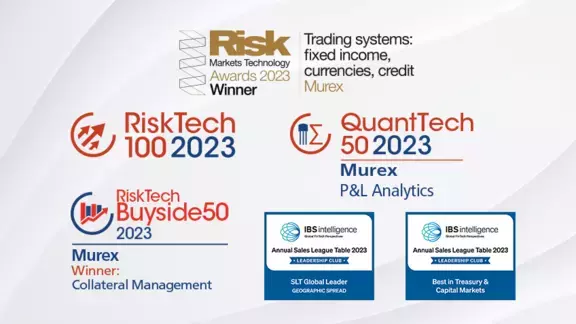-
Our solutions
- Our clients

With 300 clients and 60,000 users spread across 60 countries around the world, Murex has a truly international client base of capital markets participants.
view all case studies- Insights
- Who we are

Our awards highlight a strong level of customer satisfaction and acknowledge our market expertise.
Visit our awards webpage- Our partners
- Careers
As LIBOR, Similar Benchmarks Phase Out, Alternative Reference Rate Adaptation is Key
By Stella Clarke, Chief Marketing Officer, Murex
Paris, France – September 29, 2020
Since the 2008 financial crisis, regulators have been calling for the end of the London Interbank Offered Rate. They have two main motivations—the risk of rate manipulation due to the benchmark’s determination process relying on expert judgement from panel banks, and with the increased scarcity of underlying transactions, LIBOR does not reflect nor support the market’s real worth.
Beyond LIBOR, similar benchmarks share the same weaknesses.
A huge amount of progress has been made over the past two-and-a-half years. Alternative reference rates (ARRs) have been defined and reformed.
These new rates and existing benchmarks have fundamental differences:
-
Governance. All ARR indices will be administered directly by central banks. (LIBOR used to be governed by the private sector.)
-
Transparency. As ARRs reflect the cost of borrowing (securely or not) cash overnight, the fixing is in arrears and defined from the large volume of observable transactions on the repo market or short-term funding markets.
Technology lies at the heart of financial institutions’ ability to overcome transition hurdles and meet the fast-approaching deadline, which remains January 1, 2022.
Let’s delve into a few of those challenges.
How is the industry adopting ARRs and rebuilding interest rate markets from scratch in an accelerated timeline?
So far, the results have been quite encouraging—but slow. There have been changes in short-term swap derivatives and volumes are slowly growing. In debt markets, the issuance of products referencing RFRs has accelerated since the start of the year. Large banks and supra-nationals are leading the way. Ultimately, however, stronger guidance will be needed to force adoption.
This has not been ignored by regulators—in conjunction with working groups, they are issuing guidelines to smooth the transition. The Bank of England and the Financial Conduct Authority have both announced the cessation of the issuance of cash products linked to sterling LIBOR by the end of the first quarter of 2021. This was delayed by the COVID-19 crisis.
Despite the pandemic, and in contrast to other regulations, regulators and industry bodies recently reaffirmed their commitment to the January 1, 2022, deadline. (Read this Risk.net Q&A on how the pandemic might impact discontinuation.) The discontinuation announcement could even come as early as end of 2020, as Edwin Schooling Latter, the head of markets policy at FCA, said in June.
Moreover, regulators and working groups such as the Alternative Reference Rates Committee in the United States are issuing clear and consistent guidelines to favor the transition and enforce target cessation dates.
Specifically from a technology standpoint, trading, risk and settlement systems need to be enhanced to support the new benchmarks and related instruments in a post-LIBOR world. When switching at scale to daily compounding computation, a performance impact is expected, especially for large enterprise risk batch load or for intraday risk monitoring. Systems need to be redesigned to cope with the change and maintain current performance levels without requiring additional computing power.
Additionally, there are challenges for implementation and functionality.
These challenges include switching from in-advance fixing to daily compounding; maintaining the bp spread across €STR and EONIA curves; and developing indices and associated curves for an increasing variety of ARRs. There is also the additional challenge of defining term rates when they become available, and for options and structured products, a major impact on valuation models will require adaptation across the value chain with model validation.
The transition of legacy positions referencing LIBOR after 2021
Working groups across the world have collaborated to define the transition. The approaches recommended by groups in various jurisdictions are similar.
Despite the parallels, there are significant variations in the detailed implementation. These details will impact financial institutions, especially regarding the technology investments and enhancements required for smoothing out the transition. These details fall into three categories: supporting an orderly bulk switch of PAI and discounting at CCPs followed by renegotiation for individual CSAs; effectively managing the bulk index transition for derivatives and cash products; and supporting specific contractual fallback rate computations. For example, systems need to be adapted to handle all the technicalities of the ISDA fallback mechanism.
The new ISDA IBOR fallback supplement will consist of compounded averages of risk-free rates plus the historical median of RFR-LIBOR fixing spreads. The pandemic demonstrated that RFR and LIBOR rates are significantly decorrelated, and as a result, depending on how those rates respectively move, their difference could be sharp. Pricing, valuation and risk calculation, therefore, will need to take this so-called “cliff effect” into account until discontinuation. (Read more about the cliff effect in this Risk.net article).
The discounting switch on EUR and USD at the major clearing houses is expected to catalyze the liquidity on longer-term swap tenors. The switch from EONIA to €STR went smoothly on July 27, but has so far had a small impact on the amount of €STR risk traded.
There are also interesting developments in the Asia-Pacific region, with many similarities and some differences between jurisdictions. In Singapore, as the SOR benchmark uses the USD LIBOR in its computation, it will be replaced with SORA after 2021, while in Thailand, KBank and CIMB already completed the first transaction based on THOR, proposed as the replacement rate for the THBFIX.
What we have seen so far
To date, financial institutions have seemed to favor a product-by-product approach, with a mix of strategies for transition management. Regardless of the approach financial institutions eventually settle on to cope with the transition, technology will prove critical in ensuring a smooth transition to the new reference benchmarks.
All actors—sell-side, buy-side and infrastructure—need to be able to trade, process and risk manage these new benchmarks. That will require fundamental changes in their technology platforms. Technology automation especially will be of upmost importance. At Murex, we are ready to help our clients prepare for the future transition, every step of the way.
*****
Murex’s LIBOR Solution – Helping you Prepare for the Future
Murex’s flagship MX.3 platform facilitates the transition, helping our clients to adapt to the new landscape. The solution is built around transition mechanisms and covers all aspects of the reform from discounting switch at CCPs to fallback processes. Complemented by out-of-the-box RFR indices, instruments and curves, it helps clients understand the impact every step of the way across business processes front-to-back-to-risk.
In addition, our global team of experts provide our clients with any extra support and guidance they require throughout the LIBOR transition.
You might be interested in ...
- Our clients


